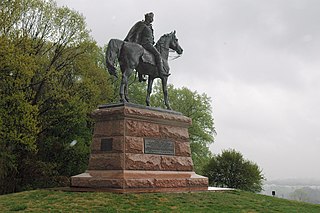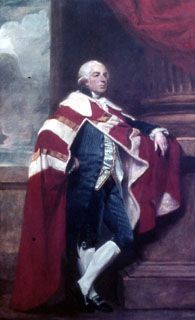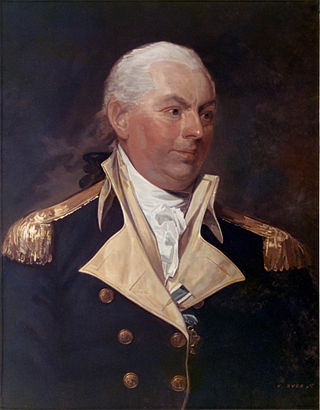USS Delaware was a 24-gun sailing frigate of the United States Navy that had a short career in the American Revolutionary War as the British Royal Navy captured her in 1777. The Royal Navy took her in as an "armed ship", and later classed her a sixth rate. The Royal Navy sold her in 1783. British owners named her United States and then French interests purchased her and named her Dauphin. She spent some years as a whaler and then in March 1795 she was converted at Charleston, South Carolina, to French privateer. Her subsequent fate is unclear.
Effingham, a 32-gun frigate of the Continental Navy named after Thomas Howard, 3rd Earl of Effingham. She was built at Philadelphia in 1776 and 1777, and Captain John Barry was ordered to command her. When the British took possession of Philadelphia in September 1777, Barry was ordered to take the uncompleted ship up the Delaware River to a place of safety.
The first USS Hornet was a merchant sloop chartered from Captain William Stone in December 1775 to serve under Stone as a unit of Esek Hopkins' Fleet. The voyage would be the first military action for master's mate Joshua Barney. The vessel was damaged while sailing with the fleet and returned to base. Hornet patrolled Delaware Bay until being captured on 27 April 1777 by the Royal Navy. Hornet was taken to Jamaica, where the ship was found to be leaking and was condemned.

Commodore John Rodgers was a United States Navy officer who served during the Navy's formative years from the 1790s through to the late 1830s. He served under six presidents and for nearly four decades. His service took him through numerous military engagements of the Quasi-War, both Barbary Wars, and the War of 1812.

Andrew Doria was a brig purchased by the Continental Congress in November 1775. She is most famous for her participation in the Battle of Nassau—the first amphibious engagement by the Continental Navy and the Continental Marines—and for being the first United States vessel to receive a salute from a foreign power.

Nicholas Biddle was one of the first five captains of the Continental Navy, which was raised by the Continental Congress during the American Revolutionary War. Biddle was born in Philadelphia in 1750. He began sailing at the age of 13 and joined the Royal Navy when he was 20. In 1773, he sailed the Arctic with Constantine Phipps and Horatio Nelson. When the Revolutionary War began in 1775, Biddle joined the Continental Navy and commanded several ships. In 1778 off the coast of Barbados, Biddle confronted HMS Yarmouth, a 64-gun British warship. After a twenty-minute battle, Biddle's ship Randolph suddenly exploded, killing him and most of his men. Four ships of the U.S. Navy have been named in his honor.
Isaiah Robinson was a captain in the Continental Navy during the American Revolutionary War.

Fort Mifflin, originally called Fort Island Battery and also known as Mud Island Fort, was commissioned in 1771 and sits on Mud Island on the Delaware River below Philadelphia, Pennsylvania near Philadelphia International Airport.

The Pennsylvania Navy served as the naval force of Pennsylvania during the American Revolution and afterward, until the formation of the United States Navy. The navy's vessels served almost exclusively on the Delaware River, and were active in first defending the approaches to the city of Philadelphia during the British campaign that successfully occupied the city in 1777, and then preventing the Royal Navy from resupplying the occupying army.

The Philadelphia campaign (1777–1778) was a British military campaign during the American Revolutionary War designed to gain control of Philadelphia, the Revolutionary-era capital where the Second Continental Congress convened, formed the Continental Army, and appointed George Washington as its commander in 1775, and later authored and unanimously adopted the Declaration of Independence the following year, on July 4, 1776, which formalized and escalated the war.

The Frederica naval action was a naval battle during the American Revolutionary War in which three galleys of the Georgia State Navy captured a British raiding party off the coast of Georgia. The action occurred on April 19, 1778.

The Battle of Red Bank, also known as the Battle of Fort Mercer, was fought on October 22, 1777, during the American Revolutionary War. A British and Hessian force was sent to take Fort Mercer on the New Jersey side of the Delaware River just south of Philadelphia, but was defeated by a smaller force of Continental Army troops.

HMS Augusta was a 64-gun third rate ship of the line of the Royal Navy, launched on 24 October 1763 at Rotherhithe.

Fort Mercer was an earthen fort on the eastern shores of the Delaware River in New Jersey that was constructed by the Continental Army during the American Revolutionary War. The fort was built in 1777 by Polish engineer Thaddeus Kosciuszko under the command of George Washington. Along with Fort Mifflin on the Pennsylvania side of the Delaware River to its west, Fort Mercer was designed to block the British advance on the revolutionary capital of Philadelphia during the Philadelphia campaign.

USS Fly was an eight-gun sloop in the Continental Navy. She was part of a squadron that raided the port of Nassau and engaged the 20-gun HMS Glasgow.
USS Spitfire was a row galley authorized and constructed by Rhode Island during the American Revolution, and was placed in service in 1776 in the Rhode Island Navy. During this age of sail, row galleys were highly maneuverable compared to sailing ships whose movements were dependent on the wind. Spitfire had a reportedly successful career, helping to capture British cargo ships and engaging in the fight against British warships.

The siege of Fort Mifflin or the siege of Mud Island Fort, which took place from September 26 to November 16, 1777, saw British land batteries commanded by Captain John Montresor and a British naval squadron under Vice Admiral Lord Richard Howe attempt to capture an American fort in the Delaware River that was commanded by Lieutenant Colonel Samuel Smith. The operation finally succeeded after Smith was wounded. His successor, Major Simeon Thayer, subsequently evacuated the fort on the night of November 15, enabling British troops to occupy the place the following morning.

American colonial marines were various naval infantry units which served during the Revolutionary War on the Patriot side. After the conflict broke out in 1775, nine of the rebelling Thirteen Colonies established state navies to carry out naval operations. Accordingly, several marine units were raised to serve as an infantry component aboard the ships of these navies. The marines, along with the navies they served in, were intended initially as a stopgap measure to provide the Patriots with naval capabilities before the Continental Navy reached a significant level of strength. After its establishment, state navies, and the marines serving in them, participated in several operations alongside the Continental Navy and its marines.

Francis Reynolds-Moreton, 3rd Baron Ducie was a Royal Navy officer, politician and peer who sat in the British House of Commons representing the constituency of Lancaster from 1784 to 1785. He is best known for his service in the American Revolutionary War and Fourth Anglo-Dutch War. Reynolds fought at the 1777 Battle of Red Bank during the Philadelphia campaign. During the battle, he was commander of a British squadron onboard HMS Augusta in an attempt to clear the way along the Delaware River to Philadelphia. His ship ran aground while being pursued by American Commodore John Hazelwood's squadron, and Augusta mysteriously caught fire shortly thereafter and exploded before all of the crew could abandon ship. Reynolds also commanded HMS Jupiter and HMS Monarch in several operations and saw service against the French and Dutch in the North Sea, Atlantic Ocean and Caribbean Sea.

John Barry was an Irish-born American naval officer who served in the Continental Navy during the American Revolutionary War and in the United States Navy during the Quasi-War. He has been credited by some as "The Father of the American Navy", sharing that moniker with John Paul Jones and John Adams, and was appointed as a captain in the Continental Navy on December 7, 1775. Barry was the first captain placed in command of an American warship commissioned for service under the Continental flag. After the Revolutionary War, he became the first commissioned American naval officer, at the rank of commodore, receiving his commission from President George Washington in 1797.


















